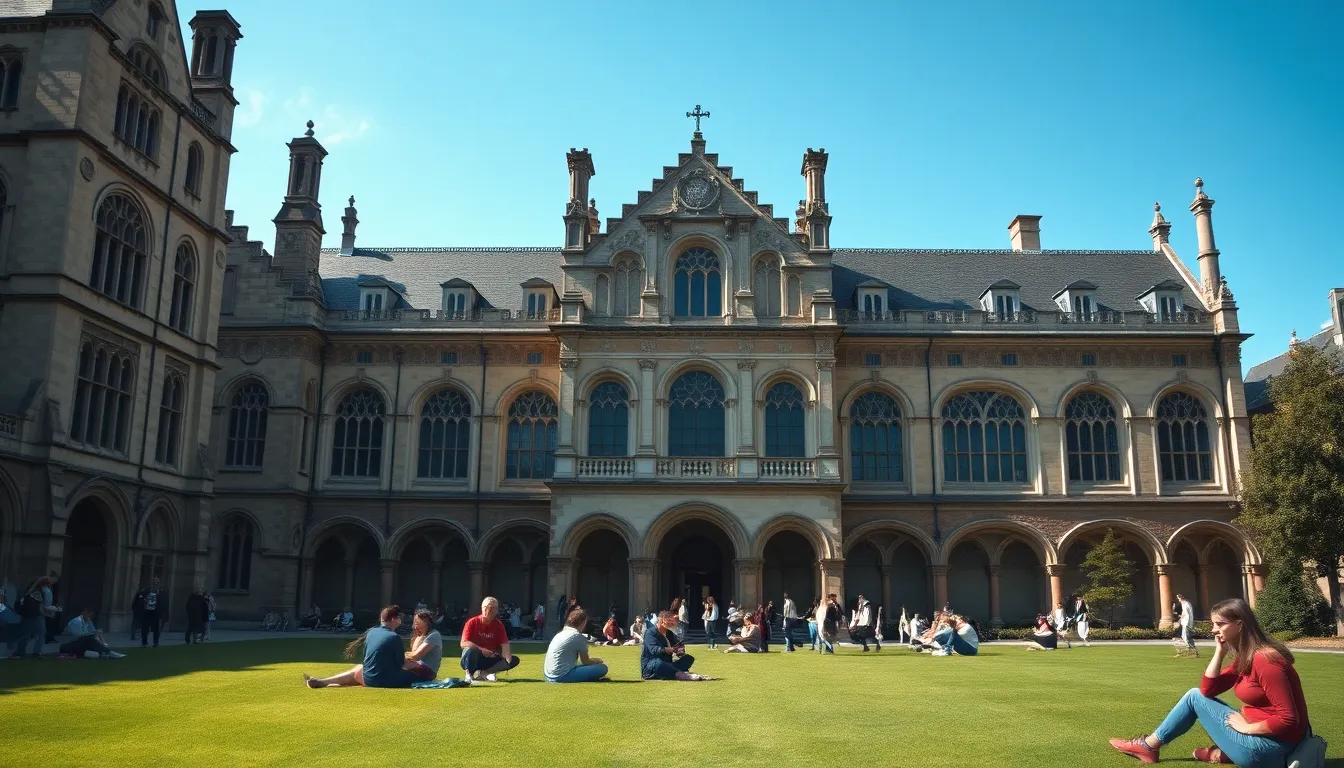University life is often painted as a glamorous adventure filled with late-night study sessions and caffeine-fueled escapades. But let’s be real—it’s a rollercoaster ride of epic proportions. From navigating dorm life to deciphering the mysterious language of professors, students find themselves in a whirlwind of experiences that shape their futures.
Table of Contents
ToggleOverview of University Education
University education encompasses various programs catering to a diverse student population. Bachelor’s degrees, typically taking four years, represent the most common form of higher education. Students select from fields such as engineering, business, liberal arts, and sciences. Master’s degrees follow bachelor’s programs, allowing specialization in specific areas. These programs generally require an additional two years of study.
Community colleges offer an alternative pathway, primarily through associate degree programs lasting two years. Students may transfer to universities after completion, reducing overall educational costs. Additionally, professional schools focus on fields such as law, medicine, and education, requiring several years of training post-bachelor’s degree.
Curricula aim to foster critical thinking, communication skills, and problem-solving abilities. Class formats vary, including lectures, seminars, and hands-on labs, encouraging student engagement and collaboration. Furthermore, internships and research opportunities play a vital role in applying theoretical knowledge to real-world scenarios.
University education represents a significant financial investment. Tuition costs vary widely, influenced by factors such as residency status and institutional type. Many students rely on scholarships, grants, and loans to finance their education. Student debt remains a pressing concern, affecting career choices and financial stability post-graduation.
Diverse student organizations and extracurricular activities enrich university life, fostering personal growth and social connections. Students often benefit from networking opportunities that enhance career prospects. Ultimately, university education impacts not only individual careers but also societal advancement, contributing to a more informed and skilled workforce.
History of Universities

Universities possess a rich and complex history that spans centuries. Their evolution reflects the growth of knowledge and societal needs.
Evolution Through the Centuries
Initially, universities emerged in medieval Europe as centers of higher learning. Bologna, Italy, founded in 1088, marked the establishment of the first university with formal legal recognition. Such institutions focused mainly on theology, law, and medicine. By the 12th and 13th centuries, several universities, including Oxford and Paris, gained prominence, advancing educational models and curricula. During the Renaissance, the humanist movement expanded disciplines by including literature, philosophy, and the sciences. The spread of the printing press further supported knowledge dissemination. Subsequent centuries saw the rise of universities worldwide, adapting to cultural and political changes while migrating towards modern educational structures.
Key Milestones in University Development
Key milestones punctuate the history of universities, showcasing their transformation. The establishment of the University of Prague in 1348 expanded education into Central Europe. The founding of the University of Heidelberg in 1386 emphasized the significance of research. The 19th century introduced the German model, emphasizing research and academic freedom. This development influenced educational reforms across the globe. Within the 20th century, universities embraced technological advancements, thus integrating diverse fields of study and fostering global perspectives. Expanding access to education became paramount, resulting in increased enrollment and the establishment of community colleges. Such milestones influenced the global perception of university education’s value and its role in driving societal progress.
Types of Universities
Universities come in various forms, each serving distinct educational purposes. Understanding these types provides clarity on the options available to prospective students.
Public vs. Private Universities
Public universities receive funding from the government, which helps keep tuition costs lower. Students often find larger campuses and a wider range of programs at these institutions. Private universities, on the other hand, rely primarily on tuition and private donations, resulting in higher costs. They frequently promote smaller class sizes and a more personalized education experience. Both types may offer excellent academic programs, yet their funding structures and student experiences differ significantly.
Community Colleges and Their Role
Community colleges provide accessible education through two-year associate degree programs. These institutions serve as a cost-effective option for students seeking a university transfer later. Many community colleges offer vocational training alongside academic courses, equipping students with job-ready skills. Enrollment in community colleges continues to rise due to their affordability and flexibility. They emphasize local community engagement, often partnering with regional businesses to enhance workforce development initiatives and pathways into higher education.
University Experience
University life presents a unique blend of academic and social opportunities, creating a pivotal phase in a student’s journey. The experience encompasses diverse components that shape personal and professional growth.
Academic Life and Curriculum
Class formats vary significantly, adapting to student needs. Traditional lectures, seminars, and online courses promote flexibility. Students engage in specialized programs designed for their future careers. Bachelor’s degrees generally span four years, while master’s degrees allow for deeper specialization. Curricula emphasize critical thinking, communication, and problem-solving skills. Internships and research projects enhance practical learning and provide real-world experience. Faculty members often bring industry insights, enriching the learning environment.
Extracurricular Activities and Social Life
Student organizations offer a wealth of opportunities for involvement. Clubs focused on academic, cultural, and recreational interests foster community. Social events, sports, and volunteer activities enrich campus life. Participation enhances networking skills and boosts resumes. Cultural exchanges broaden perspectives, exposing students to diverse backgrounds. Engaging in these activities promotes personal development, builds lasting friendships, and improves overall university satisfaction. Ultimately, balancing academics and social life creates a holistic university experience.
The Future of Universities
Universities face a rapidly changing landscape shaped by technological advancements and societal needs. These institutions adapt by incorporating innovative teaching methods and technologies to enhance the learning experience.
Trends and Innovations in Education
Blended learning models emerge as popular choices, combining traditional classroom instruction with online components. Adaptive learning technologies personalize education, catering to individual student needs. Online degree programs gain traction, offering flexibility for working students and non-traditional learners. Gamification of learning increases engagement, utilizing game-like elements to motivate students. Additionally, interdisciplinary studies expand, preparing graduates for diverse job markets and innovative career paths.
Challenges Facing Higher Education
Rising tuition costs pose significant barriers for many students, prompting concerns over accessibility and student debt. Universities grapple with balancing funding needs and affordability. Enrollment declines create competition among institutions, leading to program cutbacks. Furthermore, evolving job market requirements pressure universities to update curricula and focus on workplace readiness. Finally, maintaining diversity and inclusion remains crucial as institutions strive to provide equitable opportunities for all students.
University life is a multifaceted journey filled with both challenges and opportunities. It plays a crucial role in shaping individuals and society as a whole. The blend of academic rigor and personal growth fosters a well-rounded experience that prepares students for the future.
As universities evolve to meet the demands of a changing world they continue to provide essential pathways for education and career development. The focus on diversity and inclusion remains vital to ensure equitable access for all students. Embracing innovation in teaching and learning will further enhance the university experience and prepare graduates to thrive in a dynamic job market.





